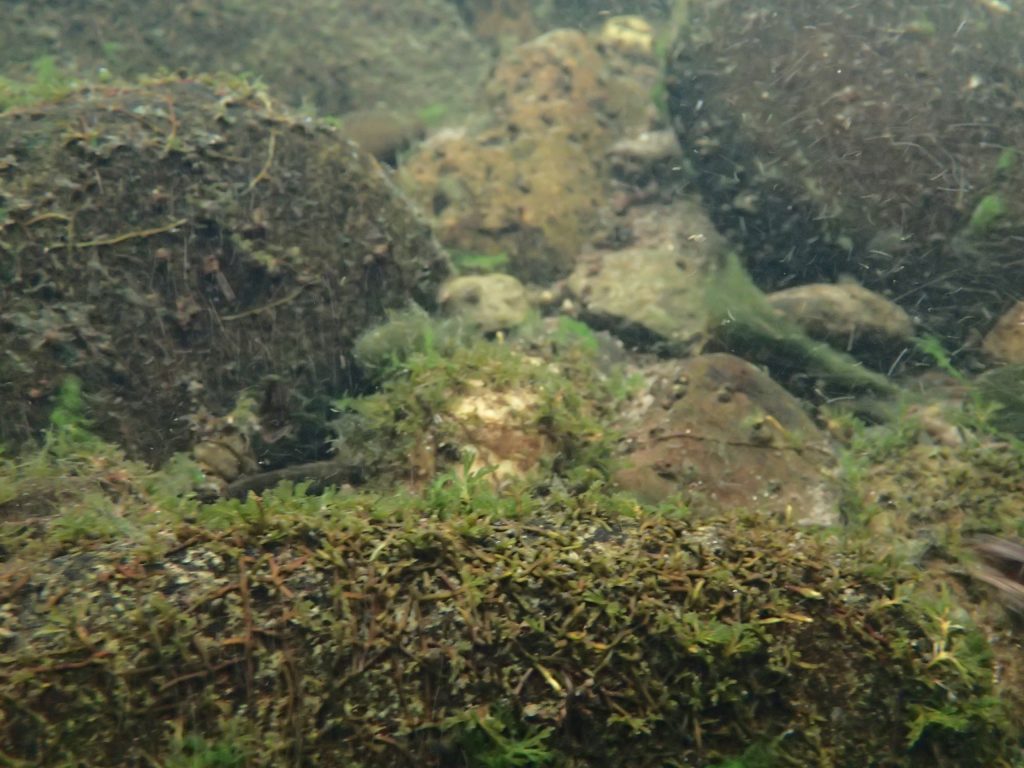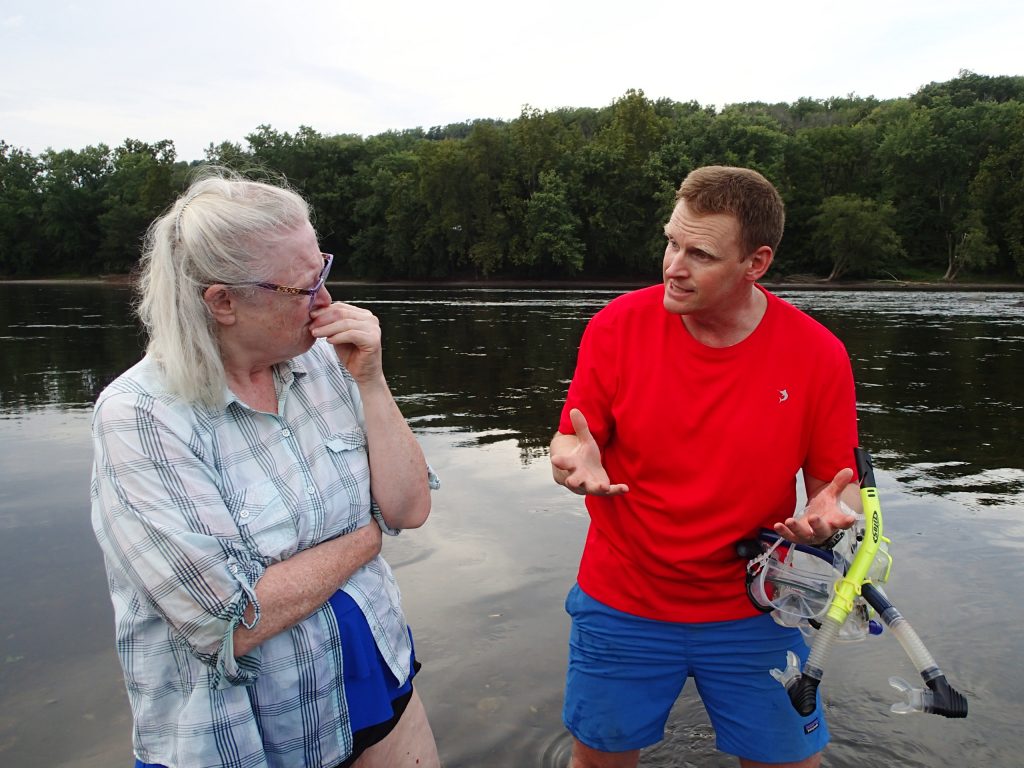
Podostemum makes a comeback in the Delaware
The plant, which has not been seen south of the Lehigh since the 1800s, is reappearing in what is seen as a hopeful sign of improving water quality.
| November 17, 2022
It’s a late August evening and Erik Silldorff is wearing a red swim shirt and blue trunks and an oversized sun hat that could practically be a sombrero.
He leads the way to a section of the Delaware River near Washington Crossing, Pa., walking over baseball-sized gray river stones that have been exposed by a prolonged lack of rainfall.
The mission this evening: Snorkel in search of Podostemum ceratophyllum, otherwise known as riverweed.
But don’t let the word “weed” in the everyday description of this plant mislead you. As Silldorff, who is an enthusiastic cheerleader for the plant (bordering on evangelical), will tell you, it is an aquatic plant whose returned presence in the Delaware is an important signal of the river’s improving health.
“It is a sign that we are indeed getting better water quality in the Delaware River,” said Silldorff, restoration director and senior scientist at the Delaware Riverkeeper Network. “That 50 years of fighting for clean water under the Clean Water Act has made a difference, and not just for a chemical parameter here and there. But a difference for things that live in these rivers and streams, even supersensitive species like Podostemum.”
Reappearance in 2013
In 2013, when Silldorff was working for the Delaware River Basin Commission, a then-intern, Micah Swann, was doing snorkel surveys for mussels and found a batch of Podostemum about 30 miles south of the Lehigh River, within the Trenton city limits, near Rotary Island, Silldorff said.
“I followed up to confirm it was indeed a live patch of Podostemum, and was blown away by how big and lovely a patch it was!” he recalled.
Up until then, the last time such a sighting occurred below the Lehigh was in the late 1800s, Sildorff said. Since then, he said he has found new patches every other year. “It’s really coming back, footstep by footstep,” he said. “We’re starting to build momentum.”
The plant has also been spotted in Neshaminy Creek south of the Lehigh and in Tobyhanna Creek in Monroe County, Pa., north of the Lehigh, both in 2015, said Timothy A. Block, the John J. Willaman Chair of Botany and director of plant science at the Morris Arboretum of the University of Pennsylvania. The appearances in the Neshaminy are probably re-occurrences, he said, because the plant had been collected there decades ago.
As for a full understanding of why the plant dies out, “we simply do not know,” Silldorff said.
“It is a sign that we are indeed getting better water quality in the Delaware River.” — Erik Silldorff of the Delaware Riverkeeper Network
He theorized that the Lehigh, which is not as clean and has higher nutrient concentrations than the Delaware, could be impeding the plant’s growth. One of many pollutants in the Lehigh River are in concentrations just too high for Podostemum to survive near the confluence of the Delaware, he said.
It is a “very sensitive aquatic plant — literally, it might be most sensitive plant in our entire ecosystem,” Silldorff said in Delaware Riverkeeper Network video.
While Podostemum can tolerate nutrient loads and sedimentation, acid mine drainage from coal mines appears to be its Kryptonite.
Thus, describing the plant’s resurgence as a signal of clean water as a “canary in the coal mine” is a misapplied idiom because it is runoff from coal mines that is believed to most threaten the plant’s viability.

Block said it is generally accepted that pollution and siltation negatively affect Podostemum.
“I would speculate that the fact that it seems to be making something of a comeback, especially in a stream like Neshaminy Creek, may be due to decreased development activity,” Block said, adding that there are not that many places left to develop in southeastern Pennsylvania.
Unique characteristics
Podostemum are as unique as its name is difficult to pronounce.
Susan Munch, a retired biology professor from Albright College in Reading, Pa., who wrote a paper about Podostemum that was published in The Journal of Pennsylvania Academy of Science in 1993, described it as a “very odd plant.” Despite its appearances, it is not slippery the way moss or algae might be, she said.
James Wood, an assistant professor of biology at West Liberty University in West Liberty, W.Va., who has studied the plant, said, “People get excited about it because it’s so strange.”
Unlike most plants, which rely on roots to stay in place, Podostemum have holdfasts that combine the mechanisms of suction cups with some kind of glue that it secretes. It has been known to grow on boulders and rocks but also on concrete piers, plastics, car tires and even a metal road sign, Wood said.
Podostemum, a flowering plant with seeds but no petals, can look like wavy curly kale or angel hair pasta and appear in green, red or black hues, Wood said.

It’s been found in fast-moving water, such as rivers and waterfalls, in the Eastern United States, from Georgia up to Canada, and in some places in Central Ameria. This makes it unusual because rivers are not necessarily the most hospitable places for plants, given the changing dynamics of water levels and speed and siltation that can block out sunlight, researchers said.
Though its first appearances were documented in the 1800s, it’s not a plant that’s necessarily been well inventoried.
“Botanists did not put their faces in fast-flowing rivers,” Wood said, adding, “Rivers are incredibly frustrating to work in.”
Wood said the plant should be thought of as a forest on the river bottom. As such, it contributes to the larger ecosystem and a diversity of habitat for organisms from snails to invertebrate and insects, which, in turn, draw fish.
“So, the return of Podostemum is the return of a key and missing habitat, and a key and missing component of the food web,” Silldorff said.
The plant’s presence is a hopeful sign worth celebrating, he said.
“Everyone who’s in the business of environmental work struggles with despondency at times,” he said. “You’re always fighting the tide and hope you’re making headway.”







